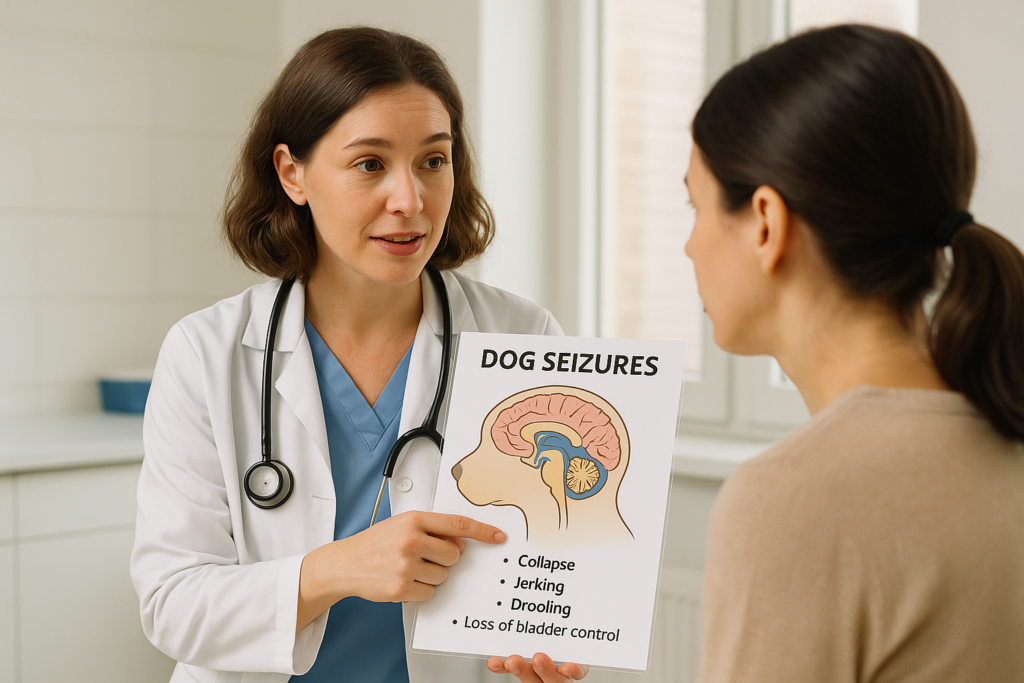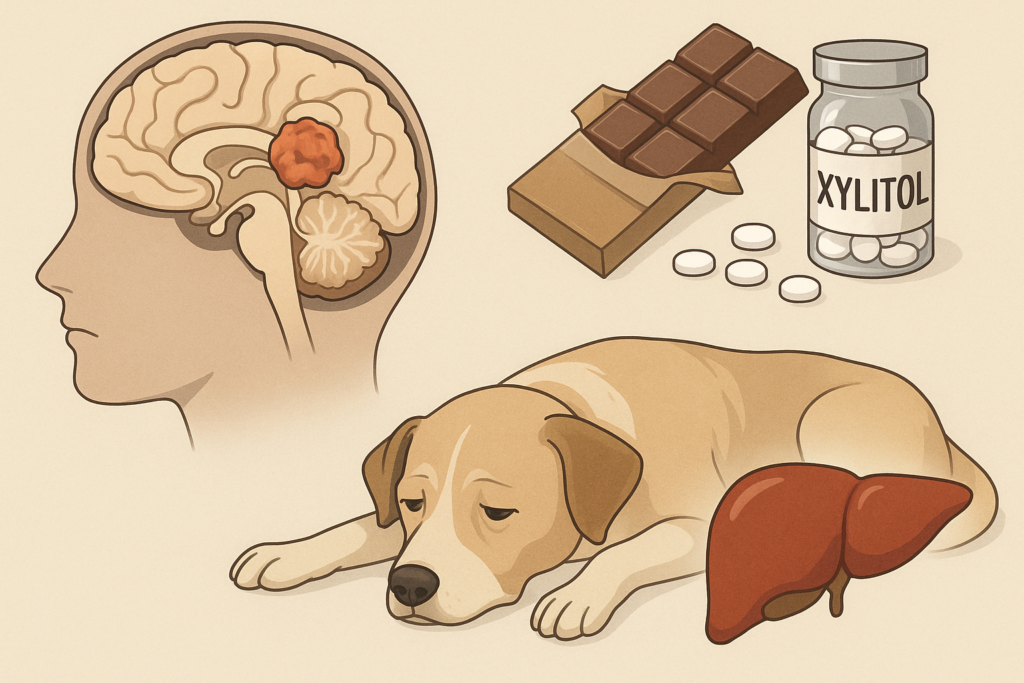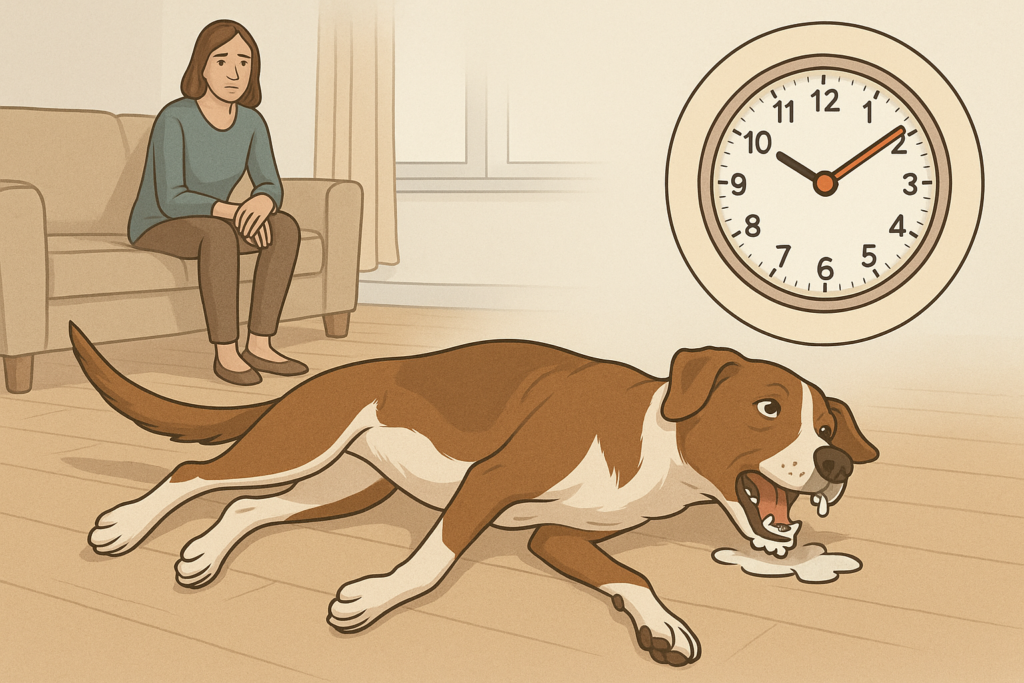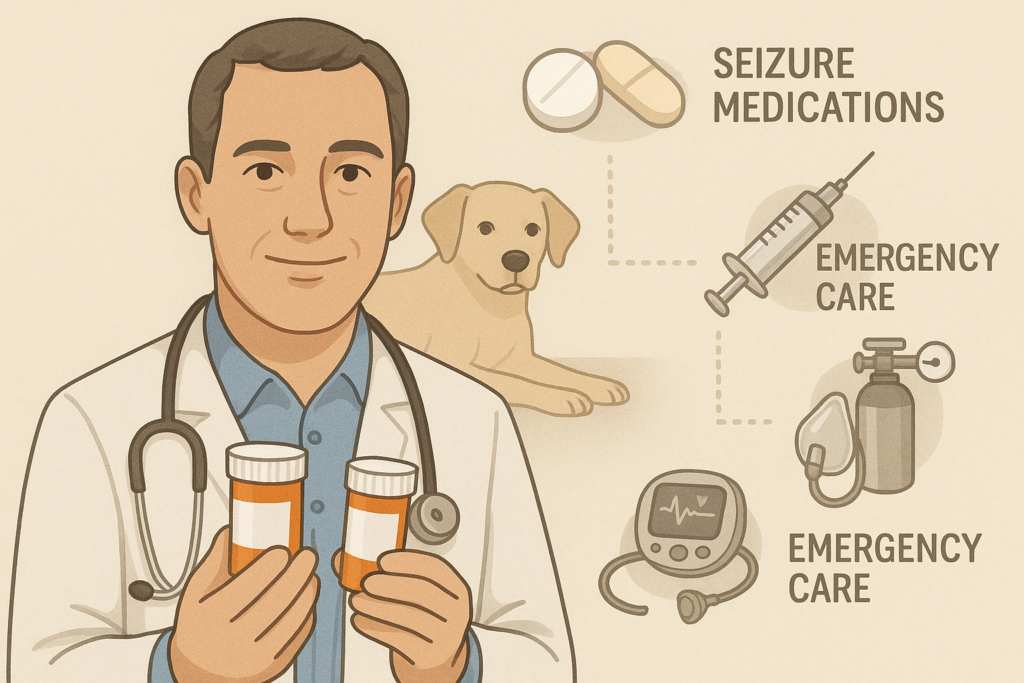Table of Contents
Introduction
Watching your beloved dog go through a seizure can be one of the most terrifying moments as a pet owner. Whether it’s your dog’s first seizure or part of an ongoing struggle with dog seizures, the sense of helplessness and fear is real. I’ve been in that position, sitting beside a Labrador retriever in my clinic as she convulsed on the floor her owner in tears, uncertain of what to do next. But with the right support, most dogs with seizures can lead full, happy lives.
In this guide, we’ll break down everything you need to know about dog seizures from identifying early signs to effective treatment options. You’ll also find practical advice for what to do during a seizure, what it may cost in Canada, and how to support both your pet and yourself through this journey.
Key Takeaways
- Dog seizures are one of the most common neurological conditions in dogs and can range from mild to life-threatening.
- They may be caused by genetic epilepsy, structural brain issues, metabolic imbalances, or toxins.
- Recognizing the phases of a seizure before, during, and after can help keep your pet safe and aid in diagnosis.
- Emergency care is needed for seizures lasting more than 5 minutes or occurring in clusters.
- Long-term treatments include anti-seizure medications, diet changes, and alternative therapies like CBD under veterinary guidance.
- Keeping a seizure diary and regular vet visits are key for managing your dog’s health.
- Most dogs with seizures can live long, fulfilling lives with the right care.
Table of Contents
- What Are Dog Seizures?
- What Causes Dog Seizures?
- How to Recognize a Seizure
- Diagnosis: What Your Vet Will Do
- Treatment Options for Dog Seizures
- Home Checklist: What to Do During a Seizure
- Canadian Cost of Dog Seizure Care
- Preventing and Managing Seizures Long-Term
- Emotional Support for Pet Parents
- Frequently Asked Questions (FAQs)
- Summary Table: Quick Reference Guide
- Conclusion
What Are Dog Seizures?
You can also visit: https://doglifeexpert.com/hot-spots-on-dogs-5-powerful-home-remedies/

Dog seizures are sudden, uncontrolled bursts of electrical activity in the brain that lead to temporary disturbances in behavior, movement, or consciousness. These episodes are not diseases themselves but symptoms of an underlying neurological disorder. Seizures can range from brief, mild episodes like momentary staring to full-body convulsions lasting several minutes.
Common Types of Dog Seizures
- Generalized (Grand Mal) Seizures: These affect the entire body. Dogs may fall over, paddle their legs, drool excessively, or lose consciousness. These are the most dramatic and easiest to recognize.
- Focal (Partial) Seizures: These occur in one part of the brain and affect a specific area of the body. You might notice facial twitching, lip licking, or unusual behavior like fly-biting.
- Cluster Seizures: Multiple seizures within a 24-hour period. These can be dangerous and often require emergency intervention.
- Status Epilepticus: A seizure lasting more than 5 minutes or consecutive seizures without recovery in between. This is a life-threatening emergency.
Breeds Commonly Affected by Dog Seizures
Certain breeds are genetically predisposed to dog seizures, especially those with a tendency for idiopathic epilepsy. These include:
- Border Collies
- German Shepherds
- Golden Retrievers
- Labrador Retrievers
- Belgian Tervurens
- Australian Shepherds
As a practicing veterinarian, I’ve seen several young Border Collies brought in with their first seizure between the ages of 1 and 3. Owners are often shocked, but with quick intervention and proper treatment, these dogs typically go on to live happy, well-managed lives.
Understanding the type and frequency of your dog’s seizures helps your veterinarian determine the best treatment approach.
What Causes Dog Seizures?

To effectively manage dog seizures, it’s crucial to identify their underlying cause. While some seizures are due to a chronic condition like idiopathic epilepsy, others may be a one-time event triggered by toxins or metabolic disturbances. Veterinary diagnostics aim to place the seizure into one of four primary categories.
1. Idiopathic Epilepsy (Genetic Seizures)
This is the most common cause of dog seizures, especially in dogs aged 1 to 5 years. Idiopathic epilepsy is believed to have a hereditary component, though no structural brain abnormalities are found on diagnostic imaging. It’s particularly prevalent in:
- Border Collies
- Australian Shepherds
- Golden Retrievers
- Labrador Retrievers
- Beagles
- Vizslas
While the seizures themselves can be dramatic, most dogs with idiopathic epilepsy respond well to long-term anti-seizure medications.
2. Structural Epilepsy (Brain Abnormalities)
These dog seizures are caused by a physical problem within the brain such as:
- Brain tumors: More common in older dogs, especially over age 7.
- Head trauma: From accidents or falls.
- Encephalitis: Brain inflammation from autoimmune conditions or infections like distemper.
- Hydrocephalus: A buildup of cerebrospinal fluid, typically in puppies.
- Stroke or vascular issues
If your vet suspects structural epilepsy, advanced imaging like MRI or CT scans is usually recommended. I once diagnosed a brain tumor in a 10-year-old Boxer using MRI after a sudden onset of cluster seizures. Unfortunately, in some cases, the condition may be inoperable, and palliative care becomes the focus.
3. Reactive Seizures (Metabolic or Toxic Causes)
Reactive dog seizures occur due to problems outside the brain, usually involving systemic or metabolic imbalances:
- Hypoglycemia (low blood sugar)
- Liver shunts or liver failure
- Kidney disease
- Electrolyte imbalances
- Anemia or low oxygen levels
These causes are especially important to rule out in young puppies or older dogs experiencing their first seizure.
4. Toxic Exposure
Ingestion of certain substances can trigger acute seizures. Common culprits include:
- Chocolate and caffeine
- Xylitol (found in sugar-free gum and peanut butter)
- Rat poison
- Antifreeze (ethylene glycol)
- Certain human medications (like antidepressants, amphetamines, or ADHD meds)
In practice, I’ve treated dogs with dog seizures after licking antifreeze off a garage floor or ingesting human medication. Immediate vet care often saves the pet, but permanent liver or kidney damage may occur.
5. External Triggers
While not a direct cause, some factors may trigger seizures in dogs already predisposed:
- Stress and anxiety
- Sleep deprivation
- Loud noises (e.g., fireworks, thunderstorms)
- Extreme heat
Managing these external factors can reduce seizure frequency in some dogs.
How to Recognize a Seizure

Recognizing a dog seizure in real-time is essential for ensuring your pet’s safety and providing your veterinarian with accurate information. Seizures usually follow a three-phase pattern: before (pre-ictal), during (ictal), and after (post-ictal). Each phase has distinct behaviors and symptoms.
Pre-Ictal Phase (Aura)
This is the warning stage, lasting from a few seconds to several hours. Many dogs experience subtle changes before a seizure hits. Common signs include:
- Restlessness or pacing
- Whining or barking
- Clingy or hiding behavior
- Drooling or trembling
- Lip licking or glassy eyes
Owners often report their dog “seemed off” or was unusually needy before the seizure. Keeping track of these patterns helps anticipate future episodes of dog seizures.
Ictal Phase (The Seizure Itself)
This is the actual seizure and usually lasts between 30 seconds to 3 minutes. There are two main types:
Generalized Seizures (Grand Mal)
- Sudden collapse or loss of consciousness
- Limb paddling or rigid limbs
- Foaming at the mouth
- Involuntary urination or defecation
- Vocalizing or chomping jaw movements
Focal Seizures (Partial Seizures)
- Localized twitching (e.g., one leg, face, or side of the body)
- Lip smacking or fly-biting motions
- Dilated pupils
- Strange behaviors like tail chasing or disorientation
Focal seizures can evolve into generalized seizures, so even mild signs should be taken seriously.
Status Epilepticus
If the seizure lasts more than 5 minutes or if seizures occur back-to-back without recovery is an emergency. Immediate vet care is required to prevent brain damage or death.
Post-Ictal Phase (Recovery)
Once the seizure ends, your dog enters the recovery phase. Symptoms may last from a few minutes to several hours:
- Disorientation or confusion
- Temporary blindness or bumping into objects
- Wobbliness or unsteady gait
- Excessive thirst or hunger
- Anxiety or hiding behavior
During this phase, dogs are not typically aware of their surroundings. Let them recover in a quiet, safe space and avoid overstimulation.
Many of my clients find it helpful to keep a seizure diary recording when, how long, and what occurred before and after the seizure. This helps spot trends and provides crucial data for adjusting treatment.
Diagnosis: What Your Vet Will Do
When your dog experiences a seizure, your veterinarian’s first goal is to determine the underlying cause. This helps distinguish between treatable issues like toxin exposure and chronic conditions like idiopathic epilepsy. Accurate diagnosis is critical for long-term seizure control and your dog’s overall well-being.
1. Detailed History
Expect your vet to ask:
- When did the seizures start?
- How often do they occur?
- What do the episodes look like?
- Any exposure to toxins or medications?
- What was your dog doing before the seizure?
A seizure diary (dates, times, triggers, behaviors) is incredibly helpful here. This log becomes even more vital in dogs with recurrent dog seizures.
2. Physical and Neurological Exams
Your veterinarian will examine your dog’s:
- Reflexes and gait
- Eyes and pupils
- Muscle tone
- Heart and lungs
- Body temperature and hydration
This helps rule out structural brain diseases or systemic illnesses that might mimic or trigger seizures.
3. Bloodwork and Urinalysis
Blood and urine tests can uncover many causes of dog seizures, including:
- Low blood sugar (hypoglycemia)
- Electrolyte imbalances (sodium, calcium, potassium)
- Liver or kidney dysfunction
- Infections or anemia
- Thyroid disorders
In young dogs, a bile acid test might be used to screen for liver shunts. For older dogs, kidney and liver panels are especially important.
4. Imaging: MRI or CT Scan
If structural epilepsy or a brain tumor is suspected, advanced imaging is necessary. MRIs are most commonly used to visualize the brain for:
- Tumors
- Stroke
- Hydrocephalus
- Inflammatory lesions (encephalitis)
Referral to a veterinary neurologist may be needed, especially for recurring or unusual dog seizures not responding to treatment.
5. Cerebrospinal Fluid (CSF) Analysis
In cases where infection or inflammation is suspected (e.g., canine distemper, meningitis), your vet might recommend a spinal tap. CSF analysis helps diagnose:
- Autoimmune brain diseases
- Viral or bacterial infections
- Fungal or parasitic infections
While this procedure requires anesthesia and specialist equipment, it can be vital for complicated seizure cases.
When the Diagnosis is Idiopathic Epilepsy
If all tests return normal and your dog fits the profile (young, purebred, normal between seizures), your vet may diagnose idiopathic epilepsy a diagnosis of exclusion. In these cases, seizure control, not cure, becomes the focus of treatment.
Treatment Options for Dog Seizures

Treatment for dog seizures depends on the underlying cause, frequency, and severity of the episodes. The primary goal is to reduce how often seizures occur and minimize their intensity while preserving your dog’s quality of life.
Emergency Seizure Management
Seizures lasting longer than 5 minutes or multiple seizures within 24 hours are emergencies. In these cases, your vet may:
- Administer IV anticonvulsants: Such as diazepam or midazolam to stop the seizure immediately.
- Provide oxygen support and monitor vital signs.
- Cool your dog’s body: Using fans, alcohol on the paw pads, or cold water compresses to prevent overheating.
Pro Tip: If your dog has a history of cluster seizures, your vet might prescribe emergency rectal diazepam (Valium) or intranasal midazolam for at-home use.
Long-Term Anti-Seizure Medications
If your dog has more than one seizure every 4–6 weeks, or if seizures are severe or occur in clusters, daily medication may be recommended. Common options include:
| Medication | How It Works | Side Effects | Notes |
|---|---|---|---|
| Phenobarbital | Suppresses seizure activity | Sedation, increased thirst/urination, liver stress | Requires regular blood tests |
| Potassium Bromide (K-BroVet) | Alters chloride flow in neurons | GI upset, sedation | Often used with phenobarbital |
| Zonisamide | Blocks seizure signals | Lethargy, appetite loss | Newer drug with fewer side effects |
| Levetiracetam (Keppra) | Modulates neurotransmitters | Mild sedation | Short-acting, 3x/day dosing |
| Gabapentin | For neuropathic pain and mild seizures | Sedation, weight gain | Rarely used alone |
Dogs on these medications require regular monitoring. For example, a Golden Retriever in my care needed phenobarbital but experienced mild liver enzyme elevation. We adjusted the dose and added bromide for better control.
Note: Never stop seizure medications suddenly this can cause rebound or status epilepticus. Always taper under vet supervision.
Alternative Therapies
Some pet parents explore complementary options alongside traditional medicine. While not replacements, they may offer additional support:
- CBD Oil (non-THC): Early research and anecdotal evidence suggest it may reduce seizure frequency. Choose veterinary-specific brands like ElleVet Sciences and always discuss dosing with your vet.
- Acupuncture & Traditional Chinese Medicine: May help reduce stress and improve quality of life, especially for dogs with anxiety-triggered seizures. Prescription Diets: Diets high in medium-chain triglycerides (MCTs), like Purina Pro Plan NeuroCare have shown promise in seizure management.
- Ketogenic Diet: Low-carb, high-fat diets that may reduce seizures but must be vet-supervised to prevent nutritional imbalance.
Important: These therapies should never replace conventional treatment without veterinary guidance. Use them as part of a comprehensive plan for managing dog seizures.
Home Checklist: What to Do During a Seizure

When your dog has a seizure, your quick actions can make a major difference. Here’s a simple, vet-approved 5-minute checklist to guide you during an active dog seizure.
🟠 1. Stay Calm and Safe
- Take a deep breath your dog needs you focused.
- Move furniture or sharp objects away from your dog.
- Turn off loud TVs, dim the lights, and remove other pets.
🔴 2. Do NOT Touch the Mouth
- Dogs do not swallow their tongues.
- Putting your hands near their mouth could result in a bite.
🔵 3. Time the Seizure
- Use your phone or clock to track duration.
- Note movements, vocalizations, or body part involvement.
- Record video if possible this helps your vet determine the seizure type.
🟡 4. Comfort Afterward
- Speak softly and offer gentle reassurance.
- Allow them to rest somewhere quiet and safe.
- Offer water once alert, but don’t feed until fully coordinated.
🟢 5. When to Go to the Vet
Seek immediate veterinary care if:
- The seizure lasts more than 5 minutes
- There are multiple seizures within 24 hours
- Your dog doesn’t fully recover between seizures
- It’s your dog’s first seizure ever
Keep a seizure journal noting date, time, duration, suspected trigger, and recovery symptoms. This tracking can help your veterinarian adjust treatment and spot trends over time.
In my practice, I often provide seizure emergency kits complete with rectal diazepam, a tracking sheet, and instructions to owners of dogs with frequent dog seizures. Ask your vet if one might be appropriate for your pet.
Canadian Cost of Dog Seizure Care
Managing dog seizures can be costly, especially if your pet requires long-term treatment or emergency intervention. Here’s a breakdown of typical veterinary costs in Canada to help you plan.
🧾 Initial Diagnosis Costs (One-Time)
| Service | Estimated Cost (CAD) |
|---|---|
| Physical exam | $90 – $150 |
| Bloodwork & urinalysis | $180 – $300 |
| Bile acid test (for liver shunts) | $120 – $200 |
| X-rays | $150 – $300 |
| MRI or CT scan (referral required) | $2,000 – $3,500 |
| CSF tap & analysis | $1,500 – $2,500 |
If your dog has only one mild seizure and tests normal, you might spend $300–$600. But for complex or recurring cases, the total workup can exceed $4,000–$6,000
Tip: Consider pet insurance if your dog is diagnosed with a seizure disorder early. Plans from providers like Trupanion or Petsecure may cover diagnostics, meds, and emergency care.
Preventing and Managing Seizures Long-Term
While not all dog seizures can be fully prevented, careful management can significantly reduce their frequency and severity. Creating a safe, predictable environment and following veterinary guidance is key to giving your dog the best quality of life.
✅ 1. Avoid Known Triggers
Many seizure-prone dogs react to specific environmental stressors. Common triggers include:
- Loud noises (fireworks, thunderstorms)
- Stressful events (grooming, vet visits, new pets)
- Hormonal changes (heat cycles, unneutered males)
- Flashing lights or certain sounds
- Skipped meals or sudden dietary changes
If you notice patterns in your dog’s seizures, work with your vet to minimize exposure or pre-treat with anti-anxiety meds.
🗓️ 2. Keep a Seizure Diary
Logging each seizure episode helps detect trends and informs treatment. Include:
- Date and time
- Duration and description
- Any notable events before/after
- Recovery symptoms
- Medications given
This tool is invaluable for tracking progress and adjusting therapies something I regularly rely on during rechecks with my epilepsy patients.
🩺 3. Schedule Regular Vet Check-Ups
Routine exams and lab work help monitor:
- Drug blood levels (especially for phenobarbital or bromide)
- Liver and kidney function
- Electrolyte balance
- Weight changes or side effects
Dogs with well-managed dog seizures typically need blood testing every 6 months.
💉 4. Keep Vaccinations & Preventatives Up to Date
Diseases like canine distemper and rabies can lead to seizures. Protect your dog by:
- Staying current on vaccinations
- Using flea/tick preventatives
- Keeping household toxins out of reach
🧬 5. Be Breed-Aware
Certain breeds are genetically predisposed to epilepsy or other seizure disorders. If your dog belongs to a high-risk breed, early screening and preventive planning are especially important. These breeds include:
- Border Collies
- German Shepherds
- Australian Shepherds
- Golden Retrievers
- Pugs and Boston Terriers
- Bull Terriers (can show tail-chasing seizures)
Knowing your breed’s risk helps you respond proactively to early signs of dog seizures.
🍲 Bonus Tip: Stay Consistent with Meals & Medication
Feeding and medicating your dog at the same time every day can stabilize brain chemistry and prevent breakthrough seizures. Use reminder apps or automated feeders if your schedule varies.
With structured care and ongoing monitoring, many dogs with epilepsy lead completely normal lives. I’ve followed several seizure patients for 5+ years who, thanks to stable routines and good veterinary partnerships, are thriving well into their senior years.
Emotional Support for Pet Parents
Living with a dog who experiences dog seizures can be emotionally draining. The unpredictability of episodes, fear of long-term consequences, and the daily commitment to medication and monitoring can take a toll on pet owners. It’s okay to feel overwhelmed but you are not alone.
💬 You’re Doing Better Than You Think
As a veterinarian, I’ve seen countless devoted owners who feel helpless despite doing everything right. I remember a client with a Sheltie named Molly diagnosed with idiopathic epilepsy at age two. Her mom was exhausted, waking up nightly to check on her, questioning every food and sound. With guidance and a consistent treatment plan, Molly’s seizures became rare, and her owner regained confidence and peace of mind.
🧠 Learn, Then Breathe
Knowledge reduces fear. Understanding seizure triggers, treatments, and emergency plans empowers you to manage the condition with clarity instead of panic. Revisit this guide whenever you need to remind yourself that dog seizures are manageable.
💞 Connect with Others
You’re not the only one navigating this. Try joining:
- Online support groups for pet epilepsy
- Breed-specific forums (e.g., Border Collie seizure support)
- Social media groups like “Canine Epilepsy Resources”
Hearing others’ stories and sharing your own can relieve stress and provide fresh ideas
📞 Stay in Touch With Your Vet
You’re part of a team. Don’t hesitate to reach out with questions, changes in seizure patterns, or emotional concerns. Your vet can adjust treatment or refer you to a neurologist when needed. I often reassure clients: “Even when it feels like nothing is working, there are still more tools we can try.”
🧘 Practice Self-Care
Caring for a dog with chronic illness is an act of love but you also need to rest and recharge:
- Get enough sleep
- Share responsibilities if possible
- Keep healthy boundaries (don’t obsessively check your dog overnight)
- Celebrate small wins (1 month seizure-free, a clean blood panel)
By taking care of yourself, you’re better equipped to care for your dog.
Frequently Asked Questions (FAQs)
Here are some of the most common questions pet owners ask about dog seizures, answered by a veterinarian.
1. What should I do if my dog has a seizure for the first time?
Stay calm, move objects away, and time the seizure. Once it ends, call your vet—even if it was short. A full workup may not be needed immediately, but documenting the event is important.
2. Are dog seizures painful for my pet?
No. Dogs are typically unconscious during a generalized seizure. However, they may be confused or frightened afterward during the post-ictal phase.
3. Can a dog die from a seizure?
Yes, in rare cases especially if it’s status epilepticus (lasting over 5 minutes) or if seizures occur back-to-back without recovery. These are emergencies that require immediate veterinary care.
4. Can I give my dog human seizure medication?
Never without veterinary guidance. Many human anticonvulsants are toxic to dogs. Always use medications prescribed by your veterinarian.
5. Is CBD safe and effective for dog seizures?
Some studies show potential benefits, especially for dogs with drug-resistant epilepsy. However, CBD should be vet-approved, THC-free, and used alongside not instead of prescribed medications.
Conclusion: Partnering With Your Vet for Seizure Care
Dealing with dog seizures can be overwhelming, but with the right knowledge and support system, it becomes manageable and in many cases, life goes on with tail wags and belly rubs. Whether your dog has had a single episode or lives with chronic epilepsy, the path to stability begins with understanding, patience, and a strong partnership with your veterinary team.
Most importantly, know that you’re not alone. As a veterinarian, I’ve walked this journey with countless families from the first frightening seizure to years of successful management. Many dogs with epilepsy live full, active lives with the right combination of medication, lifestyle support, and love.
So stay informed, stay observant, and never hesitate to advocate for your pet. Your dog depends on you but you’ve got backup. With your commitment and your vet’s guidance, you can navigate dog seizures with confidence and compassion.





Pingback: Canine Hip Dysplasia: 7 Alarming Facts on Causes, Symptoms & Treatment
Pingback: 7 Powerful Reasons Why Your Dog Losing Hair (Plus Vet-Backed Solutions)
Pingback: 5 Shocking Signs of Chocolate Poisoning in Dogs